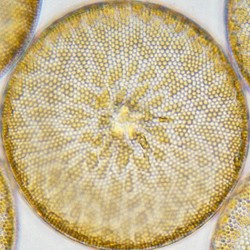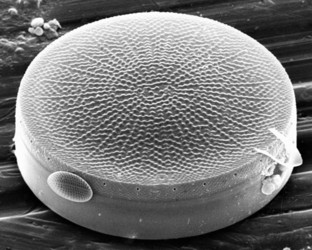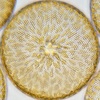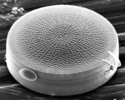'radial centric diatoms'
David G. MannSome molecular phylogenies indicate that the radial centric diatoms are paraphyletic with respect to a monophyletic group containing the polar centric diatoms and pennate diatoms. There is little support for monophyly or paraphyly. The radial centrics are regarded as a class or (Coscinodiscophyceae) or subdivision/subphylum (Coscinodiscophytina) by some authors



This tree diagram shows the relationships between several groups of organisms.
The root of the current tree connects the organisms featured in this tree to their containing group and the rest of the Tree of Life. The basal branching point in the tree represents the ancestor of the other groups in the tree. This ancestor diversified over time into several descendent subgroups, which are represented as internal nodes and terminal taxa to the right.

You can click on the root to travel down the Tree of Life all the way to the root of all Life, and you can click on the names of descendent subgroups to travel up the Tree of Life all the way to individual species.
For more information on ToL tree formatting, please see Interpreting the Tree or Classification. To learn more about phylogenetic trees, please visit our Phylogenetic Biology pages.
close boxIntroduction
The radial centric diatoms have circular valves and lack obvious signs of bi- or multipolarity in the arrangement of special pores or processes (there are very rare exceptions). They are probably a paraphyletic group of lineages that split from each other before the evolution of more complex (non-circular) valve shapes in the ancestors of the 'polar centric diatoms'. Current molecular data do not give a clear picture of the relationship between the radial centrics and the polar centrics, nor of the relationships among major groups within the radial centrics.
The definition of radial centrics is in fact wholly negative. They are those lineages of diatoms that (1) have circular valves because they lack the special siliceous bands that force the auxospore to expand anisometrically, (2) lack fultoportulae and so are not circular-valved members of the Thalassiosirales, and (3) do not possess the synapomorphies of the few other groups of diatoms that have circular valves.
Even if the radial centrics do prove to be monophyletic (e.g. as in the diagram of Sims et al. 2006, fig. 2), it is highly unlikely that any morphological features will be consistently useful for diagnosis.
If they are paraphyletic, we can hope that a classification will eventually be developed that truly reflects evolutionary relationships. In the meantime, the name 'radial centrics' is simply a shorter and more descriptive quick-reference than 'lineages that probably diverged from each other earlier than all except one of them from the polar centrics (including pennates), that lack a sternum, that have an annulus but lack fultoportulae and discrete areas of porelli, and that lack elongate or multipolar shapes through having a simple auxospore wall'.
The radial centric diatoms are mostly planktonic and marine, but there are interesting exceptions. Ellerbeckia arenaria is often semi-terrestrial, occurring on damp shady rocks. Some Melosira species occur in freshwater periphyton, and Aulacoseira is an important component of freshwater phytoplankton, usually in well-mixed water columns.
Characteristics
- chain-forming or solitary
- valves circular (very rare exceptions with elliptical or hemielliptical valves)
- distance between valves (pervalvar depth of the girdle) sometimes short, sometimes so long that the cell becomes spicular (Proboscia and Rhizosolenia: see right-hand title illustration)
- valve pattern subtended by a circular annulus
- auxospore wall scaly, without a properizonium or perizonium
- rimoportulae or tube processes present, but no fultoportulae
- lacking well-defined areas of small pores (porelli) for secretion of pads or stalks
Discussion of Phylogenetic Relationships
The relationships between the major groups of radial centrics are unclear and many groups of species and genera have not been studied in detail, nor included in molecular phylogenies. Ellerbeckia sol (also called 'Paralia sol') sometimes appears as sister to all other diatoms (e.g. Medlin & Kaczmarska 2004, Alverson et al. 2006), and Leptocylindrus also sometimes splits off very early (e.g. Alverson et al. 2006, Sorhannus 2007).
The rich Lower Cretaceous flora described by Gersonde & Harwood (1990) contains several genera that possess the characteristics of radial centrics, i.e. with circular valves but without features that might place them among the polar centric lineages (discussed by Medlin & Kaczmarska 2004, Sims et al. 2006). Some of these show no obvious links to any of the extant groups of radial centrics.
Medlin & Kaczmarska (2004) refer to the radial centric diatoms as the subdivision Coscinodiscophytina.
References
Alverson, A.J., Cannone, J.J., Gutell, R.R. & Theriot, E.C. (2006). The evolution of elongate shape in diatoms. Journal of Phycology 42: 655-668.
Gersonde, R. & Harwood, D.M. (1990). Lower Cretaceous diatoms from ODP Leg 113 site 693 (Weddell Sea) Part 1: vegetative cells. Proceedings of the Ocean Drilling Program, Scientific Results 113: 365–402.
Medlin, L.K. & Kaczmarska, I. (2004). Evolution of the diatoms: V. Morphological and cytological support for the major clades and a taxonomic revision. Phycologia 43: 245–270.
Round, F.E., Crawford, R.M. & Mann, D.G. (1990). The diatoms. Biology and morphology of the genera. Cambridge University Press, Cambridge. 747 pp.
Sims, P.A., Mann, D.G. & Medlin, L.K. (2006). Evolution of the diatoms: insights from fossil, biological and molecular data. Phycologia 45: 361-402.
Sorhannus, U. (2007). A nuclear-encoded small-subunit ribosomal RNA timescale for diatom evolution. Marine Micropaleontology 65: 1-12.
Title Illustrations

| Scientific Name | Coscinodiscus |
|---|---|
| Identified By | David G. Mann |
| Life Cycle Stage | Vegetative phase |
| Image Use |
 This media file is licensed under the Creative Commons Attribution-NonCommercial License - Version 3.0. This media file is licensed under the Creative Commons Attribution-NonCommercial License - Version 3.0.
|
| Copyright |
© 2008 David G. Mann

|
| Scientific Name | Actinocyclus |
|---|---|
| Specimen Condition | Dead Specimen |
| Identified By | David G. Mann |
| Life Cycle Stage | Vegetative phase |
| Body Part | theca |
| View | external, SEM |
| Copyright |
© 2008 David G. Mann

|
| Scientific Name | Rhizosolenia |
|---|---|
| Reference | G. Karsten (1905). Das Phytoplankton des Antarktischen Meeres nach dem Material der deutschen Tiefsee-Expedition 1898-1899. Wissenschaftliche Ergebnisse der Deutchen Tiefsee-Expedition auf dem Dampfer "Valdivia" 1898-1899, 2 (2): 1-136. |
| Creator | George Karsten |
| Acknowledgements | scanned from G. Karsten (1905), plate 10, fig. 5d. |
| Specimen Condition | Live Specimen |
| Life Cycle Stage | Vegetative phase |
| View | girdle view |
| Image Use |
 This media file is licensed under the Creative Commons Attribution-NonCommercial License - Version 3.0. This media file is licensed under the Creative Commons Attribution-NonCommercial License - Version 3.0.
|
| Copyright |
© 2008 David G. Mann

|
About This Page
This page is being developed as part of the Tree of Life Web Project Protist Diversity Workshop, co-sponsored by the Canadian Institute for Advanced Research (CIFAR) program in Integrated Microbial Biodiversity and the Tula Foundation.
David G. Mann

Royal Botanic Garden Edinburgh, United Kingdom
Correspondence regarding this page should be directed to David G. Mann at
d.mann@rbge.org.uk
Page copyright © 2008 David G. Mann
 Page: Tree of Life
'radial centric diatoms'.
Authored by
David G. Mann.
The TEXT of this page is licensed under the
Creative Commons Attribution-NonCommercial License - Version 3.0. Note that images and other media
featured on this page are each governed by their own license, and they may or may not be available
for reuse. Click on an image or a media link to access the media data window, which provides the
relevant licensing information. For the general terms and conditions of ToL material reuse and
redistribution, please see the Tree of Life Copyright
Policies.
Page: Tree of Life
'radial centric diatoms'.
Authored by
David G. Mann.
The TEXT of this page is licensed under the
Creative Commons Attribution-NonCommercial License - Version 3.0. Note that images and other media
featured on this page are each governed by their own license, and they may or may not be available
for reuse. Click on an image or a media link to access the media data window, which provides the
relevant licensing information. For the general terms and conditions of ToL material reuse and
redistribution, please see the Tree of Life Copyright
Policies.
- First online 07 February 2010
Citing this page:
Mann, David G. 2010. 'radial centric diatoms'. Version 07 February 2010 (under construction). http://tolweb.org/%27radial_centric_diatoms%27/125295/2010.02.07 in The Tree of Life Web Project, http://tolweb.org/











 Go to quick links
Go to quick search
Go to navigation for this section of the ToL site
Go to detailed links for the ToL site
Go to quick links
Go to quick search
Go to navigation for this section of the ToL site
Go to detailed links for the ToL site